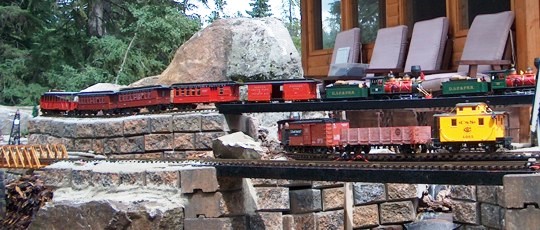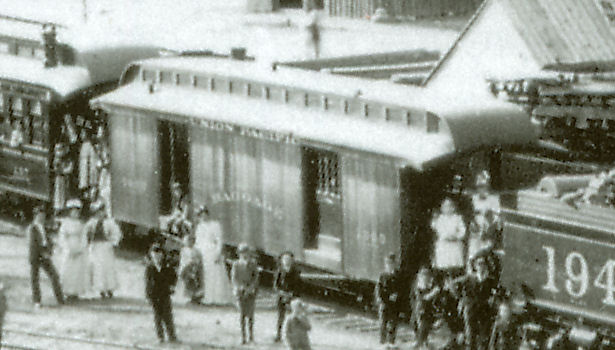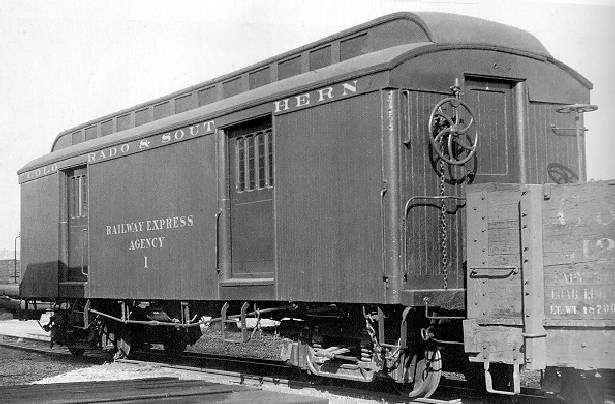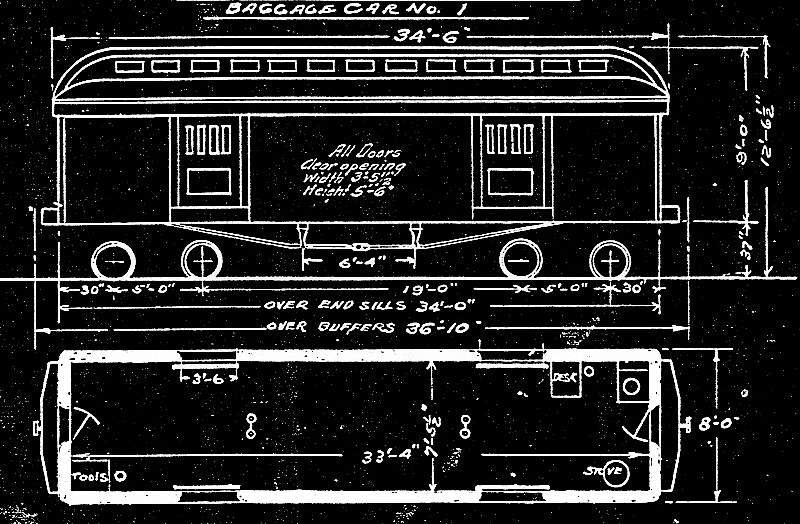|
  DENVER, SOUTH PARK and PACIFIC RAILROAD DENVER, SOUTH PARK and PACIFIC RAILROAD
DSP&P
Baggage
Cars #40, 41, and 45
Baggage cars #40,
#41, and #45 had two relatively narrow baggage doors, each centered on
the left and right half of the car, with a window on either side of
the door. There was a third door at the
center of the car with a very high threshold. It may have been used
for mail or express parcels. All three doors had square tops, and
penetrated part way through the letterboard. These
cars had end platforms and the platform roofs were
the broken duckbill style with a flat eave line. Later they were
reprofiled to the then more common bullnose style and windows were
eventually eliminated. They had decorative battens or strips that came down from the corner of
each window and the center door. They also had much more
prominent smokejacks than most cars. The strips also disappeared and
conventional T&G siding was installed. Both end platforms were
removed after entering C&S service.
Sources:
MidContinent Museum DSP&P Passenger Car
Pages
|
DSP&P |
U.P.
1885 |
DL&G
1889 |
C&S
1899 |
C&S
1906 |
|
#40 |
#1000 |
#1000 |
#102 |
#1 |
|
#41 |
#1001 |
#1001 |
#103 |
Gone |
|
#45 |
#1002 |
#1002 |
#104 |
#2 |
|
DSP&P No. |
#40 41 |
#45 |
|
Car Type |
Baggage |
|
Build
Date |
1879 |
|
Built by |
DSP&P Denver
Shops |
|
Length
Over Endsills |
34'-0" |
|
Length
Over Buffers (1916, no platforms) |
36'-10" |
37'-0" |
|
Truck
Wheelbase (1916) |
5'-0" |
5'-6" |
|
Truck
Centers (1916) |
21'-6" |
21'-3" |
|
Width
(1916) |
8'-0" |
8'-2" |
|
Height of
Body (1916) |
9'-0" |
9'-1" |
|
Body
Above Rails (1916) |
37" |
37" |
|
Clear
Opening of Doors (1916) |
3'-5 ½" x
5'-7 ¾" |
3'-5 ½" x
5'-5" |
|
Weight |
1912 |
13 tons |
16 tons |
|
1916 |
34,400
lbs. |
35,880
lbs. |
|
Wheel
Size |
1885 |
24" |
|
1916 |
26" |
|
Heating |
Stove |
|
Lighting |
Oil Lamps |
|
Interior
Finish (1916) |
Yellow
walls, white ceiling |
|
Platform
Roof |
1885 |
Broken
Duckbill |
|
1916 |
Bullnose |
|
Termination Date |
1939 |
Not yet |
 HISTORY HISTORY
Baggage cars #40
and #41 were built by the South Park’s Denver Shops in 1879,
probably from parts manufactured by one of the eastern car builders.
Baggage car #45 arrived in 1880, along with numerous passenger cars
and two baggage-mail-express cars, It was built by the Denver Shops
and was very similar to the first two baggage cars, but there were
minor dimensional differences
In 1885, the Union
Pacific renumbered #40, 41 and 45 to #1000, 1001 and 1002,
numbers they retained until 1898 under the Denver, Leadville &
Gunnison. Sometime during this period, the cars were rebuilt. Their
side windows were sheathed over and their roofs redone with the bullnose profile.
When taken over by the Colorado & Southern in 1899, DL&G #1000,
1001 and 1002 became C&S #102, 103 and 104. Baggage car #103 was
destroyed at South Park Junction in June 1902, after being wrecked
in a head-on collision.
During the C&S
renumbering in 1906, #102 became baggage car #1 and #104 became #2.
Both were rebuilt in 1915 when the end platforms were removed. Both
were officially dismantled in 1939, but #2 actually lives on at the Stuhr
Museum of the Prairie in
Nebraska.

A double-headed DSP&P passenger train on the Rocky Mountain House,
Leaverite and Northern tracks in Alberta. Locos and cars are LGB
models with roofs painted black.
 PHOTO GALLERY PHOTO GALLERY

DSP&P baggage car #40, 41, or 45 in the early 1880's,
showing positions of side windows and center door.

Denver, Leadville & Gunnison baggage car #1000 (ex DSP&P #40) at
Morrison 14 June 1892. Windows have disappeared and roof profile
has the bullnose style over the platforms.

C&S baggage car #1 (ex DSP&P #40) at Denver, 12 August 1936. with
end platforms gone
 FOLIOS and PLANS FOLIOS and PLANS
This plan by John
Maxwell shows the side windows and center door of the original DSP&P
baggage cars #40, 41, and 45 and include the end platforms. Plan is
based on the first photo in the Photo Gallery above. The plan below
the 1880's version represents the cars in the early C&S era, with
end platforms, fewer side windows, and no center door.
DSP&P
Baggage Cars #40,
#41, and #45 -- C&S #1 and #2
DSP&P Baggage Cars
#40, 41, and 45, later #1000 to 1002
C&S Baggage Cars #101 to 104 (later #1 to 4)

.
These folios of
the the DSP&P baggage cars show their configuration after 1906. You
will need to add the side windows, center side-door, and end platforms to
visualize their appearance in the DSP&P era of the 1880's. Body
dimensions should still match the original cars.
DSP&P #40
and #41 -- C&S #1

DSP&P #45 -- C&S #2

|

 DENVER, SOUTH PARK and PACIFIC RAILROAD
DENVER, SOUTH PARK and PACIFIC RAILROAD





